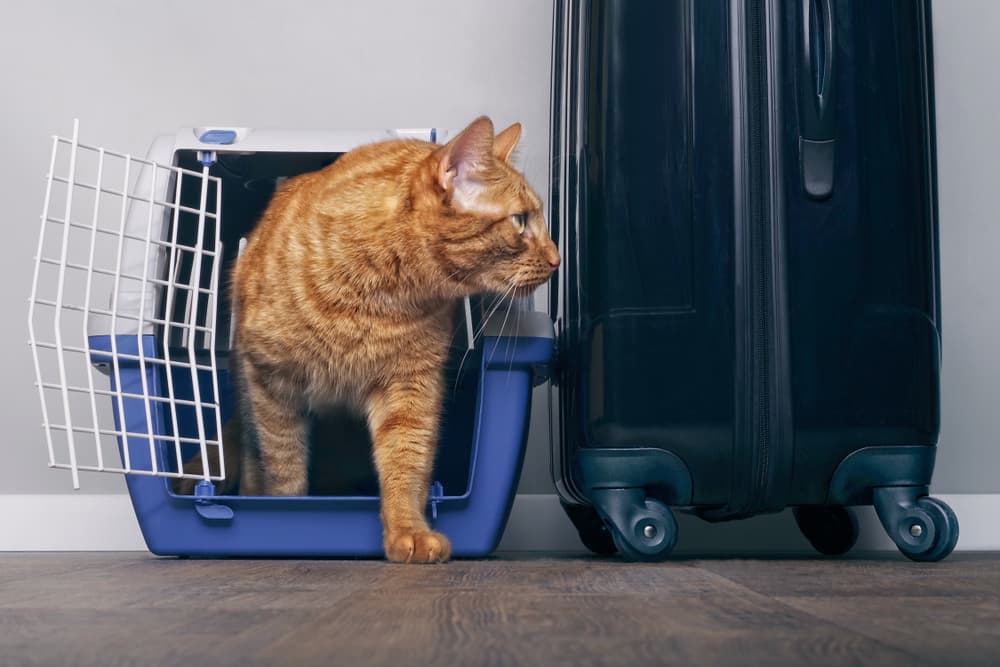People are back to traveling, for work and pleasure, and that means so are their pets. While cats may often be more low maintenance and independent than dogs, they’re still social animals who need your attention and playtime in addition to a clean litter box and fresh food and water. That means that leaving cats at home for extended periods of time while you’re away, even though they don’t need to be walked, isn’t fair to them. After reviewing your options, you might decide to have your cat travel with you.
Jennifer Van de Kieft is a certified advanced feline training and behavior professional based in New York City. She doesn’t typically recommend traveling with cats unless they are very confident and easygoing — which many cats are not. “Cats are most comfortable in their home environment.” But of course, some situations arise when traveling with your cat might be necessary, like a move or an extended visit to see family.
“I would spend some time preparing for what your cat will experience during the journey. Is it a car trip or is there a flight involved?” says Van de Kieft, whose top suggestion is carrier training your cat.
For more specific tips on how to travel with a cat, read on. The aim is that you both enjoy the journey — or at least don’t lose too much fur over it.
Benefits of Traveling with a Cat
Let’s face it: The biggest benefit of traveling with your cat is being able to have your kitty with you to pet and play with. If you’re going to be away for an extended period of time and traveling with a cat is a possibility, having them with you might reduce stress and anxiety for both pet and pet parent.
According to feline behavior consultants, cats bond to their owners and they do get lonely, making the species less independent than society might typically view them to be. Just because cats can manage with an automatic feeder and don’t need to be let out to use the bathroom, doesn’t mean they should be left alone for a day or days at a time.
If your cat is not used to being boarded and extended in-home care might be a burden, your favorite feline might appreciate the companionship and care that comes with having you there — even if it’s on the road or in an unfamiliar place.
Leaving a cat home who has unmanaged separation anxiety could result in destructive behavior such as urinating outside of the litter box, destroying furniture, or loss of appetite. If properly prepped and prepared, traveling with your cat can be a bonding experience that both of you can enjoy.
Traveling with Cats: What to Bring and Pack
While you might be on the hunt for exciting new surroundings, your pet is craving the familiarity of their routine. When traveling with your cat, be sure to bring as many things as possible along with you that make them feel at home.
Familiar items to bring include:
- Their regular food
- The same type of litter
- Their favorite treats and toys
- Blankets or bedding (even a T-shirt) that smells like their bed at home
- Any medications they might need
Additionally, consider having the following on hand for traveling:
While stronger medications such as gabapentin can be prescribed by your doctor to sedate your pet for difficult journeys like a stint in the cargo hold of a plane, over-the-counter supplements also have the potential to calm your cat into a more mellow state of mind.
See how they might react to common soothing remedies like lavender or CBD oil, or calming treats and chews that might contain chamomile, melatonin, and L-tryptophan (that sleep-inducing amino acid found in turkey). Pet parents can also find cat pheromone products in retail stores that trigger a calming effect in your fur baby.
As with any new experience for your kitty, don’t wait until the travel day has arrived to test out a new supplement, in case there are negative effects.
If your cat is suspicious of new smells or edibles, consider a “thunder shirt” or a tight-fitting piece of fabric that wraps around their body and provides comfort akin to swaddling a baby. Van de Kieft also suggests streaming calming cat music, which could help create a relaxing environment while traveling.
Traveling with a Cat on a Plane

Traveling with a cat on a plane doesn’t have to be complicated. Here are some key tips to help the journey go smoothly.
Read Up on Cabin Rules
The good news for jet-setting cat parents is that their fur babies are almost guaranteed admittance to the cabin—with all the proper papers, of course. The weight limit to fly with an animal companion under your seat is about 20 pounds. Unless you have a particularly chunky kitty, most cats should manage to adhere to the weight requirement.
However, some flights and routes require all pets to travel in the cargo hold. If that’s the case, make sure to purchase the right type of secure cat crate and discuss sedation or anti-anxiety medications with your vet prior to travel, if you think your kitty will be overly stressed by the situation.
Obtain a Copy of Your Cat’s Medical Records
Regardless of size, all cat owners are required to provide an updated health certificate, obtained from your vet, that verifies your pet has all their required vaccinations and is physically fit to travel. If you are flying internationally, additional vaccines or paperwork might be required, so be sure to start the process of researching and gathering what you need weeks before you depart.
Invest in a Quality Cat Travel Carrier
Having the proper pet carrier is key to keeping your cat safe and comfy during the journey. Search for carriers that might advertise an “airline-approved” label, which ideally combine plush, removable bedding with secure zippers and mesh for proper airflow. Make sure your cat has enough space by measuring them from their nose to the base of their tail and adding a few inches so that they can easily turn around inside of the carrier.
If your cat is required to travel in the cargo hold of a plane, you’ll want to shop for a hard-sided crate with food and water dishes to keep your cat as secure and cared for as possible while they are flying without you.
Double Check With Your Airline
While they are mostly similar, each individual airline has their own set of carrier size requirements, necessary paperwork, and additional fees that are charged to bring a pet. The best course of action is to contact the airline prior to booking to be sure you understand everything that’s being asked of you before your cat tags along for the flight.
Traveling with a Cat in the Car

Bringing your cat with you in the car is similar to how they would travel with you on an airplane, but there are a couple things specific to road trips to keep in mind.
Secure Cats in the Car
Never under any circumstance should someone drive with a cat on their lap or roaming freely around the car. A carrier or crate still gives them a secure and cozy space within the vehicle to rest and relax during the trips. Crates and carriers should be buckled in, similar to a child’s car seat. Carefully follow each manufacturer’s instructions.
Beat the Heat
Never leave a cat unattended in a hot car for even short amounts of time. The temperature can quickly rise and lead to dehydration or heat stroke. Keep the temperature in your car comfortable at all times during the trip.
Schedule Plenty of Stops
On road trips, distances are typically longer than flights and the distraction of driving means you won’t be able to tend to your kitty with every needy meow. Schedule stops every 2 hours or so to give your cat a break to stretch their legs, let them roam around the car, and have the chance to use that travel litter box.
If you plan on hitting the road often, consider leash training your cat and using a cat harness for walks outdoors. This will allow them to get some fresh air and explore each new place with their own four paws, while still safely within your grasp.
Practice Car Trips Ahead of Time
One key difference of prepping for a road trip with your cat is that you have the benefit of familiarizing them with your car ahead of time. If you can, take advantage of the ability to warm your kitty up to being in the car with positive reinforcement.
As with any new environment, your feline should be given time and space to sniff and explore their surroundings. Maybe start by offering a treat in the backseat while parked in the driveway. Then gradually work their comfort level up to starting the engine of the car but remain parked. Once your cat feels more at ease, take them for a short spin around the block (secured within their carrier), see how they react to the A/C or windows being down, and reward them for their bravery.
Traveling with a Cat on a Train

A train is similar to a flight in the sense that you can’t just pull over any time you want to give your cat a break. Preparing in advance of your train travel will help ensure you don’t hit a snag.
Read Up on Carrier and Baggage Policies
Amtrak is one of the largest passenger rail companies in the U.S., and they allow cats to board their trains on most routes — but only on journeys up to seven hours (including transfer time on multi-leg trips). The combined weight of your cat and the carrier must be less than 20 pounds. Similar to the airlines, carriers must adhere to carry-on baggage policies and pet owners will be subject to providing the proper paperwork and paying a $26 fee.
If you’re considering bringing your kitty on an exotic international rail adventure, be vigilant about the availability, requirements, and safety procedures for bringing a cat aboard the train.
Get Your Cat Used to the Carrier
When traveling with cats on a train, they often are required to be in their carrier at all times. Just like you would when preparing for a flight, make sure you introduce your cat’s carrier to them in advance and get them comfortable with being in the carrier for extended periods of time. Use positive reinforcement—like treats and plenty of praise—at home when practicing.
Book Train Tickets for Non-Peak Hours
Certain train routes—especially if they are used by commuters—can get packed during peak and busy times. Try to schedule your tickets during less busy times to avoid overcrowded train cars, which could lead to a more stressful situation for you and your feline friend.
How to Travel with a Cat Like a Pro: Other Tips

Planes, trains, and automobiles all welcome cats, in varying degrees, but that doesn’t mean that your kitty will be a savvy traveler at first — or ever. Here are some things to help make all trips with cats a little bit easier:
Carrier Training is Key
Crate or carrier training is essential. It doesn’t matter if you are in your own car or a train car, your cat should be familiar and comfortable with being zipped up or closed into a carrier. The crate will be their safe space on the road, rails, or in the air, so it makes sense that they view it as such well before you leave home.
“To start, prepare the carrier by cleaning it, adding fresh enticing bedding, then leave it out in an attractive spot in your home such as a table, closet or secure shelf and put treats, toys and/or catnip inside,” says Van de Kieft. “You may consider clicker training to reward your cat for entering the carrier. Every time your cat is inside the carrier, provide praise and a treat.
Once your cat is comfortable inside, close the door and take him into another room, and give him a treat. Get your cat used to being moved while inside in the safety of your own home. Next, go outside and walk around, then return. Next, try a short car ride. Never take the next step if your cat appears stressed. Only if your cat is comfortable, take the training up a notch and always consider your cat’s comfort level and provide high value reinforcers such as delicious treats.”
Create a Peaceful Environment
If possible, try to secure your cat in a quiet spot while traveling and keep things calm by providing familiar blankets, bedding or toys in their carrier during trips. You can drape lightweight blankets over carriers to help keep cats free of overstimulation—just make sure there is plenty of airflow.
Talk and Reassure Your Cat During the Trip
Just because your cat will spend most of your trip to a new location in a carrier or crate doesn’t mean you have to ignore them. Talk to them, sing to them, or feed them some treats. You can also set up the carrier so that your cat always has a vantage point and can see you during the trip.
Try Calming Aids
While not all calming aids will work for all cats, you can ask your veterinarian for some suggestions and try a few before your trip to see if they help. Calming treats, CBD oil, or pheromone sprays and diffusers may help while on the go or at your destination.
Foster a Sense of Adventure
More adventurous kitty-cats might relish the opportunity to be your adorable, whiskered travel partner (we’ve all seen the videos of people who are hiking cross-country or kayaking with their cat in tow). If your pet is one of these exploration-happy cats, consider other ways to bring them along with you like cat travel backpacks. These provide a window for your wide-eyed feline to bird watch like never before as you walk around country roads or city streets.









